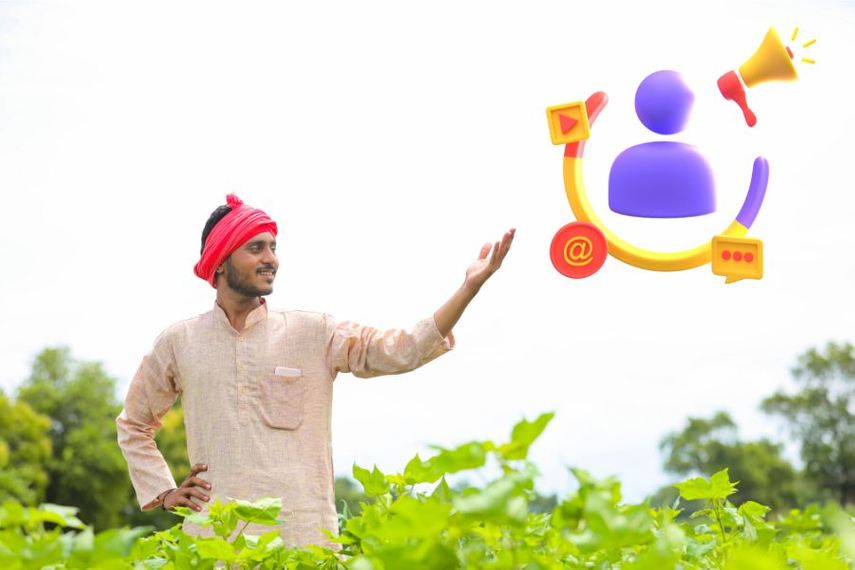
In December, brothers Santosh and Akash Jadhav found themselves on stage at YouTube's Impact Summit in Delhi—a far cry from their humble beginnings in Sangli, a small town in Maharashtra. The duo are the brains behind Indian Farmer, a YouTube channel that has transformed agricultural conversations across India.
What began as a heartfelt side project to share their love for farming has grown into a digital powerhouse, amassing over 5 million followers. The siblings tackle real-world farming challenges, from combating leaf blight infestations to boosting crop yields, offering solutions that resonate deeply with India’s agricultural community.
Their channel doesn’t just inform; it inspires. By blending practical advice with a passion for the soil, the brothers have reshaped the narrative around farming, showing it as a profession of innovation and potential. For millions of viewers, Indian Farmer has become more than a channel—it’s a movement to elevate agriculture’s stature and empower farmers nationwide.
This shift in agricultural narratives underscores a larger transformation in how the sector is being marketed—a field traditionally resistant to change but now at the cusp of modernisation through innovative strategies and farmer-centric approaches.
Breaking barriers in a conservative market
Agriculture, inherently conservative, resists rapid change. Prameek Jain, founder of Palette Creative, a creative agency, notes, "Change brings uncertainty, something that the human nature instinctively shies away from. And this resistance is most evident in India, which has predominantly been an agrarian nation, and where farmers are used to traditional farming methods."
Despite this, Jain highlights the growing acceptance of innovations like BT cotton, hybrid seeds, modern agrochemicals, and farm machinery. Yet, even as farmers warm to new ideas, convincing them remains a challenge. Harshvardhan Bhagchandka, president of IPL Biologicals, further explains, “The real challenge lies in effectively connecting with and educating farmers, particularly small and marginal ones. With small and marginal farmers forming the backbone of the agricultural sector, their unique needs demand a tailored approach, distinct from that of larger, more educated farming communities.”
To overcome these barriers, he outlines a dual strategy: combining on-ground demonstrations with digital solutions. “Seeing is believing,” Bhagchandka says, pointing to physical farmer meetings and product trials as crucial trust-building tools. IPL’s Project Shakti leverages social media to amplify these efforts, blending traditional and digital marketing in what the company calls ‘phygital marketing’.
Overcoming farmers' hesitation to adopt new technologies requires building trust through field demonstrations, training programs, and farmer-focused initiatives. By involving them in product testing, companies can establish credibility. Dhanuka's senior deputy general manager, Ratnesh Pathak emphasises trust-building through field demonstrations, on-ground training, and farmer-centric initiatives.
He advises that communication should be tailored to emphasise immediate benefits like higher yields, water savings, and better soil health, addressing farmers' practical concerns effectively. Campaigns like ‘India Ka Pranam, Har Kisan Ke Naam’ (India’s salute to every farmer) celebrate farmers' contributions while encouraging adoption of new practices.
Tailoring strategies for a diverse landscape
India’s agricultural diversity—spanning regions, climates, and cropping patterns—necessitates a localised approach. Jain highlights the need for region-specific crop advisories, tailored to unique agro-climatic conditions. "The same crop may require distinct practices in the north compared to the south due to variations in climatic and geographical conditions," he says.

Regional nuances extend to communication. Aniket Gosavi, a cotton farmer in Akola explains, “We work closely with Welspun and their on-field teams engage with farmers like us. What I appreciate is that they connect with us in our native languages, ensuring clear and relatable communication.”
He mentioned that the company ensures all materials, including brochures and digital content, are available in regional languages. This approach broadens accessibility and enhances effectiveness. Localisation is crucial in India, where agriculture varies widely due to diverse climates, soil types, and cropping patterns, making generic strategies impractical.
Bhagchandka concurs, emphasising IPL’s Regional Crop Schedule approach. “We provide tailored recommendations aligned with local soil health, pest pressures, and climatic challenges. By combining localised communication with customised solutions, we empower farmers to achieve better productivity.”
This regional focus also informs outreach methods. While traditional methods like field visits dominate in some areas, tech-savvy regions benefit from digital tools such as webinars and social media campaigns.
Overcoming scepticism around emerging technologies
New technologies like drones often face scepticism, particularly among small-scale farmers. Pathak notes that live demonstrations showcasing drones’ efficiency and cost-effectiveness are essential. Testimonials from early adopters and local influencers further build trust.
Besides roping in Yuvraj Singh as the brand ambassador, IPL involves credible third parties, such as Krishi Vigyan Kendras and agricultural scientists, to validate products through trials. The company leverages their expertise to validate solutions, ensuring farmers trust the recommendations.
Many agriculture companies, like Plantix, also work closely with various influencers, including Indian Farmer, going beyond digital social media. Some also collaborate with university professors, research scientists, and other experts who can provide credible and informed recommendations to farmers. Involving these stakeholders in product trials and demonstrations and leveraging their expertise can validate their solutions. Additionally, they can collaborate with these institutions for product testing, ensuring that their recommendations carry weight and are trusted by local farmers.
Jain underscores the role of community-driven success stories. “We amplify local success through physical meetings and digital media, enabling farmers to learn from their peers’ experiences. This strategy builds trust and drives adoption.”
Creative farmer engagement beyond traditional ads
While OOH and TV ads remain staples, innovative engagement strategies are redefining agricultural marketing. Pathak highlights field demonstrations as a dual-purpose tool: educating farmers and showcasing product efficacy. These events are complemented by digital platforms like WhatsApp, YouTube, and Facebook, where regional content and success stories are shared.
Bhagchandka points to IPL’s Biofields and Bio-Stations, which integrate traditional and biological farming methods. “Farmers witness the synergy of combining chemical and biological solutions, seeing tangible benefits in real-time,” he explains. Hundreds of such fields are being developed across India, serving as live demonstrations of sustainable practices.

Sakpal admits that these field visits also foster peer-to-peer learning. “Some farmers in our village, including me, have become like the brand ambassadors and poster boys for change. While we do promote some of the company’s products within our community, the main idea is to spread awareness about effective farming practices,” he added.
Integrating sustainability into marketing
Sustainability is becoming a cornerstone of agricultural marketing. Companies highlight the role their products play in promoting sustainability, from preserving water resources to improving soil quality and reducing environmental harm.
Their campaigns aim to inform farmers about sustainable farming methods, encouraging them to embrace practices that benefit the ecosystem. To measure success, they collect feedback via periodic surveys and analyse participation data from field activities and online initiatives. These findings guide adjustments to their strategies and provide a clearer picture of how well eco-friendly practices are being adopted.
Pathak emphasises Dhanuka’s focus on environmental benefits, from water conservation to improved soil health. Campaigns educate farmers on adopting eco-friendly practices, positioning them as stewards of the environment.
Tracking the impact of these messages involves surveys, engagement metrics, and feedback from field events. Bhagchandka highlights IPL’s efforts to measure adoption rates and refine strategies based on actionable insights.
Agricultural marketing in India is undergoing a profound transformation, balancing education, trust-building, and sales. As Bhagchandka aptly puts it, “A one-size-fits-all approach is ineffective in a sector as diverse as agriculture.”
By embracing localised strategies, integrating technology, and prioritising sustainability, industry players are not just promoting products—they are reshaping how farming is perceived and practised. For a sector steeped in tradition, this evolution is nothing short of revolutionary.
As the Jadhav brothers and campaigns like FarmDost and Project Shakti demonstrate, innovative marketing has the power to inspire, educate, and elevate agriculture to new heights. In a field long resistant to change, the seeds of transformation are finally taking root.


.jpg&h=334&w=500&q=100&v=20250320&c=1)
.jpg&h=334&w=500&q=100&v=20250320&c=1)



.jpg&h=334&w=500&q=100&v=20250320&c=1)



.jpg&h=334&w=500&q=100&v=20250320&c=1)

.jpg&h=268&w=401&q=100&v=20250320&c=1)






